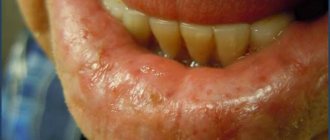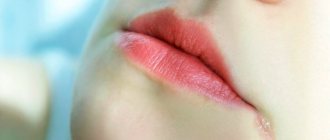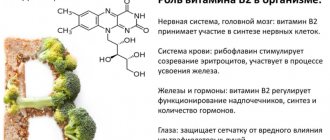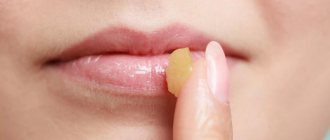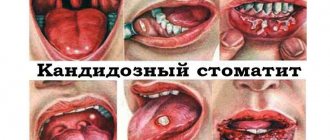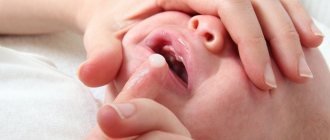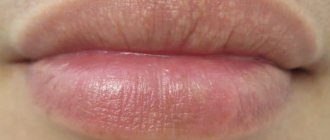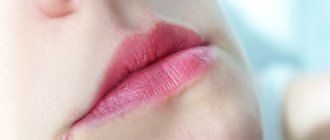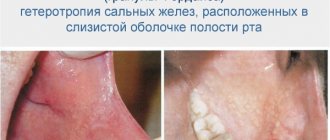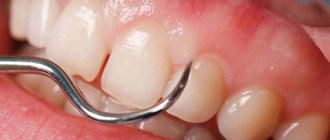General information
Cheilitis (synonyms for jamming, cheilosis) is a disease of the lips, characterized by inflammation of the red border, skin/mucous membrane of the lips, manifested by a change in the structure of their surface and color.
The term “cheilitis” is a generalized name for lip diseases, uniting a large group of lip tissue diseases that differ in etiology and clinical features. The integumentary tissues of the lips are represented by the mucous membrane, skin and red border, which, being related in morphology, differ in the ways of maintaining homeostasis and reaction to external stimuli. The skin of the lips, like the skin of the face, is exposed to various changing external factors (temperature fluctuations, drying, humidity, sun rays, etc.), but the protective ability of the epithelium of the red border of the lips is lower compared to the skin of the face, which is due to the absence of a layer of keratinized cells and pigment that protects against ultraviolet rays. Lips become especially dry when there is a sudden change in temperature and in the sun, and chapped lips occur when exposed to strong winds.
Also, an extremely important condition for ensuring the homeostasis of the integumentary tissues of the lips and their adequate response to external stimuli is the closure of the lips at rest, since the mucous membrane of the lip, adapted to a humid and warm environment, is subject to drying, exposure to sunlight, wind and low temperatures when lip closure is disrupted. The main reasons that contribute to impaired lip closure include: breathing through the mouth, pathology of the bite, impaired tone of the orbicularis oris muscle, bad habits (thumb/tongue sucking, lip biting), short frenulum.
The condition of the red border of the lips is largely determined by the condition of the gastrointestinal tract. Thus, cheilitis in patients with chronic gastrointestinal diseases occurs in 22.8-32.5% of cases, and cracked lips in 3.5-12.0%. The aggravating influence of a number of somatic diseases on the occurrence/course of cheilitis ( hepatitis , gastritis , colitis , cholecystitis ), as well as diseases of the cardiovascular, respiratory and endocrine systems, which have a negative impact on the condition of lip tissues, which contribute to the development of cheilitis, has been revealed.
According to an epidemiological dental examination of the general human population, cheilitis (seizures) in adults is diagnosed in 3.9% of subjects, while the most common pathology of the red border of the lips is exfoliative cheilitis (32% of cases). The disease often has a long-term recurrent nature.
The specific area of the lips includes the corners of the mouth. When the tone of the cheek muscles/fragments of m. is weakened. orbicularis oris, their physiology is disrupted, which leads to incomplete sealing of the lips and accumulation of saliva/food in the corners of the mouth, and a slight inward turning of the red border areas contributes to their maceration and subsequent infection of the areas of the “wet” corners of the mouth, causing inflammation in the corners of the lips.
Conventionally, cheilitis is divided into:
- primary cheilitis (exfoliative, meteorological, allergic-contact, actinic, glandular), occurring in the form of an independent disease;
- secondary (symptomatic) cheilitis , which is one of the manifestations of various diseases (eczematous, atopic).
Treatment with traditional methods
There are many traditional methods of treatment, but they can only be used after first consulting a doctor. It is also worth noting that traditional methods can only be an additional treatment, and not the main one.
A good remedy is calendula lotions. Pour boiling water over two tablespoons of dried flowers, let it brew and cool. Make lotions, periodically renewing tampons. St. John's wort lotions are made in the same way. The tincture is also prepared - dry herb is poured with boiling water and infused.
Aloe vera juice - apply to the affected areas, wait until completely dry. You can make a mask - mix aloe juice with a small amount of olive oil. Apply to lips 3-5 times a day, depending on their condition.
For atopic and angular hilitis, you can drink a decoction of chamomile - it will relieve inflammation and relieve pain.
Pathogenesis
The pathogenesis of various cheilitis varies significantly. For example, the pathogenesis of glandular cheilitis is based on acquired/congenital proliferation of the minor salivary glands, which often contributes to their infection and the development of intoxication with toxins /waste products of bacteria/viruses. The pathogenesis of meteorological (actinic) cheilitis is increased sensitivity to ultraviolet radiation, cold, wind, and radiation. The development of contact allergic cheilitis is based on a response to exposure to an irritant, and atopic cheilitis is an allergic predisposition, hypovitaminous cheilitis is a deficiency of B vitamins, and so on.
In general, it should be noted that cheilitis develops when a violation of the architectonics of the lips is combined with an inadequate reaction of the integumentary tissues (red border, skin, mucous membrane) of the lip to external/internal environmental factors (reduced resistance to mycotic, pyogenic and microbial microflora, a tendency to keratoderma, allergic reactions). Also in the pathogenesis of cheilitis, the metabolic function of the skin/mucous membrane of the lip is of significant importance, for example, the high ability of the skin/mucous membrane to absorb various substances from the surface.
Why does the disease occur?
There are many reasons for this disease. The formation of cheilitis is most likely if there is a tendency to allergic reactions and other skin problems.
The lips, their skin, mucous membranes or borders will be involved in the inflammatory process, which will lead to the appearance of a jam. Their appearance can be provoked by an exacerbation of psoriasis, tuberculosis, lichen ruber, or syphilis.
In general, experts identify a number of reasons that help the formation of cheilitis:
- Negative impact of external factors. This reason includes temperature changes when changing seasons. Cold wind and dry air lead to increased dry skin, which is the primary source of the disease.
- Use of low-quality cosmetics. A number of lipsticks contain lanolin, which leads to clogging of the pores on the lips. As a result, an inflammatory process develops.
- Unfavorable state of the ecological environment.
- Tendency to allergic reactions. Allergies can be caused by contact with household chemicals, low-quality cosmetic products, and food allergens.
- Diseases of the thyroid gland and malfunction of the immune system. Weakening of the body and its protective functions leads to an exacerbation of skin diseases in various manifestations.
- Problems in the functioning of the digestive organs, liver and other chronic diseases.
- In childhood, breathing problems. Physiological abnormalities.
- Lack of vitamins. This applies to B vitamins.
Classification
The classification is based on several factors. According to etiology there are:
- Cheilitis caused by local etiological factors (mechanical, thermal, chemical trauma, radiation injury, infection, malocclusion, etc.).
- Cheilitis caused by general changes in the body (immune imbalances, allergic dermatoses, endogenous intoxication syndrome, hypovitaminosis, for example, eating during pregnancy) or somatic diseases.
- Cheilitis of unknown etiology.
According to the localization of the pathological process:
- manifestations on the skin of the lips;
- manifestations on the mucous membrane of the lips;
- changes in the red border;
- manifestations in the area of the corners of the mouth;
- combined lesions.
With the flow:
- acute cheilitis in infectious diseases: influenza , acute respiratory infections , acute herpetic stomatitis , injuries, childhood infectious diseases, etc.;
- chronic cheilitis.
According to pathomorphological changes in the tissues of the lip:
- with the formation of primary elements on the lips - inflammation, nodule (papule), tubercle, node, blister, cyst, abscess, abscess;
- with the formation of secondary elements - erosion, ulcer, plaque, crack, scale, crust, scar, atrophy, tumor.
Mashkilleyson classification:
- Actually cheilitis (meteorological, exfoliative, actinic glandular).
- Symptomatic cheilitis (contact, eczematous, atopic, macrocheilitis, cheilitis due to hypovitaminosis).
Atopic cheilitis
Atopic cheilitis is a symptom of dermatitis or neurodermatitis in children and adolescents from 7 to 17 years old. Genetics comes to the fore among the factors causing inflammation. Klinkartina is characterized by damage to the red border of the lips and skin in the area of the corners of the mouth, but does not extend to the mucous membrane. The patient is concerned about itching, erythema, swelling with inflammation of the skin in the corners of the mouth. Then peeling appears. Desensitization and corticosteroids are the treatment of choice for atopic cheilitis.
Meteorological cheilitis
Regardless of the time of year, meteorological cheilitis occurs in response to unfavorable weather for the body. The disease is chronic and occurs more often in men. The border of the lips is infiltrated, dry, congestively hyperemic and covered with small crusts.
Treatment of meteorological cheilitis consists of protecting the lips with balms and vitamin ointments.
Eczematous cheilitis
Manifests itself as a symptom of facial eczema. Allergens include components of toothpastes, lipsticks, food substances, denture materials, and the like.
Eczematous cheilitis begins with redness and small blisters filled with yellowish serous contents. The bubbles merge with each other, burst, a weeping surface is formed, then crusts. All this is accompanied by itching and swelling of the lips. The lesion quickly spreads to the skin and corners of the mouth. The disease lasts for years with frequent exacerbations.
They treat it like skin eczema - desensitization, vitamins, ointments with corticosteroids.
Causes
What causes and why do jams appear in the corners of the mouth? Cheilitis refers to polyetiological diseases and the causes of seizures are determined by the specific type of cheilitis.
Angular cheilitis (jamming, cracks in the corners of the mouth). The main reason for its development is a pronounced violation of the architectonics of the lips, caused by a decrease in the tone of the m. orbicularis oris, a malocclusion that leads to a change in the relationship of different tissues in the area of the corners of the lips, namely, the closing of the lips also involves the adjacent skin. Accordingly, deep skin folds gradually form in the corners of the mouth, which are constantly moistened with saliva, which contributes to their maceration. The causes of sticking in the corners of the mouth can also be considered: decreased immunity , and in children - the specific morphology of the integumentary tissues of the lips and imperfect protective properties.
Cheilitis glandular . According to some authors, the cause of sticking on the lips is hyperplasia , heterotopia / hyperfunction of the minor salivary glands, which appear on the red border of the lips or in the Klein zone (transition zone) and intensively produce saliva. According to other authors, the main cause of glandular cheilitis on the lips is a violation of the architectonics of the lips, caused by their incomplete/incorrect closure.
Cheilitis meteorological . The cause of sticking in the corners of the lips in an adult is the unfavorable effect of meteorological/climatic factors (low/high humidity, temperature, dust in the air, wind, frost). Long-term (frequent) exposure to such factors causes dry lips and chapped lips. They often appear as a result of bad habits, for example, licking your lips causes your lips to dry out quickly, especially when exposed to wind/frost or sun.
Actinic cheilitis . The main reason is the development of an allergic reaction to delayed ultraviolet rays. Develops against the background of prolonged exposure to the sun or intense reflection of sunlight by the surface of the snow cover/water.
Exfoliative cheilitis . Only the red border of the lips is affected. The cause of the disease has not been definitively established. Some authors believe that exfoliative cheilitis occurs due to a violation of the process of proper closure of the lips. A connection has been established between the development of the disease and various types of psychopathologies (neurotic states/depressive reactions), as well as hyperfunction of the thyroid gland.
Contact cheilitis . The reason for the development of lip jams in an adult is the sensitization of lip tissues by various types of chemicals (decorative cosmetics, components of toothpastes, materials of orthodontic devices, etc.).
Atopic cheilitis . Refers to manifestations of diffuse neurodermatitis (atopic dermatitis). The causes of the disease are genetic inheritance, intolerance to food, pollen, medications, household chemicals, household dust, cosmetics, bacterial factors, autoimmune and neuropsychiatric diseases.
Eczematous cheilitis . It is a manifestation of general eczema resulting from exposure to external/internal irritants of neuro-allergic origin. Allergens can include microorganisms, various medications, food substances, toothpastes, etc.
Cheilitis due to hypovitaminosis . The cause is hypovitaminosis . What vitamins are missing in the body? Most often, cheilitis on the lips develops with insufficient intake of vitamins A , B2 (riboflavin), B6 (pyridoxine), and vitamin PP (nicotinic acid). Often, a deficiency of vitamins A and group B develops during pregnancy .
Macrocheilitis . One of the symptoms of Melkersson-Rosenthal syndrome. The etiology of the disease is not clear. It is assumed that the disease is hereditary; There is an infectious-allergic, hematogenous-infectious theory of the development of the disease, but most authors believe that the disease is of a polyetiological nature.
Heilith Manganotti . It belongs to precarcinous conditions (obligate precancer) and occurs mainly in people over 50 years of age, more often in men. The cause of the development of Manganotti cheilitis is trophic age-related tissue changes.
Symptoms and types of disease
Cheilitis on the lips can manifest itself in different ways depending on the form of the disease. Thus, the exfoliative type of inflammation appears more often in women; its main symptom is peeling. The disease is based on neurological and endocrine disorders. Peeling occurs on the red border of the lips and does not affect the skin and mucous membranes. The disease rarely spreads to the entire red border, so part of it remains unchanged.
With severe dry skin, peeling is accompanied by symptoms such as:
- feeling of dry lips;
- burning;
- formation of easily detachable scales.
The disease is long-term and sluggish, with periods of exacerbation occurring from time to time. It rarely goes away on its own. With the exudative form, pain, swelling of the lips, and the formation of large crusts may occur.
Glandular cheilitis develops against the background of the proliferation of minor salivary glands and their subsequent infection. With congenital pathologies, signs of such inflammation of the lips are present in almost all cases. Acquired overgrowth may be associated with chronic diseases of the periodontal tissues, tartar, multiple caries - diseases leading to infection of the dilated ducts. Lesions of the lower lip with this form of cheilitis are more common. The disease develops with the appearance of dry lips, which is initially easy to correct with the help of cosmetics. Subsequently, cracks begin to form, deepen and begin to bleed. The condition is aggravated by the constant desire to lick dry lips - cracks and ulcers can become weeping and become permanent due to the inelasticity of the skin of the lips.
Contact allergic cheilitis develops after exposure to an allergen - an irritant. The most common of them are components of lipsticks and other care products. Allergies can also be associated with bad habits, for example, constantly keeping pencils, pens and other foreign objects in the mouth. Musicians may develop occupational cheilitis due to constant contact of the mouthpieces of wind instruments with their lips. The main symptoms of the disease include:
- severe itching;
- burning;
- swelling of the lips;
- redness of the skin and mucous membranes.
Manifestations intensify upon contact with the allergen. Bubbles of different sizes may form; their spontaneous or accidental opening leads to the formation of ulcers and cracks. Chronic forms of allergic disease are accompanied by peeling, slight itching and the absence of other signs of inflammation.
Actinic cheilitis belongs to the category of diseases that are based on increased sensitivity to weather and other external factors. Usually occurs in response to sun exposure. Exudative forms of this disease are accompanied by the formation of crusts. Sometimes small blisters form, the opening of which leads to painful erosions. In the absence of exudate, the main symptoms are pain, dryness, and burning of the lips. Actinic cheilitis often degenerates into precancerous diseases.
In atopic cheilitis, the main cause of the disease is dermatitis of the same name, or neurodermatitis. It appears in people with an allergic predisposition, and the triggering factor can be medications, cosmetics, food products, as well as microorganisms and their waste products. The disease is accompanied by redness of the lips, itching and peeling of the red border, and damage to the corners of the mouth. After acute symptoms subside, peeling and thickening of the skin may occur. Dryness stimulates the formation of cracks.
Macrocheilitis is part of the Rossolimo–Melkersson–Rosenthal syndrome. Appears against the background of neuritis of the facial nerve and the symptom of a folded tongue. Develops due to infectious-allergic effects against the background of genetic predisposition. Manifests itself with the following symptoms:
- lip enlargement;
- severe itching;
- swelling of other parts of the face;
- bluish-pink color of swollen areas of the lips.
One or both lips, cheeks, and upper parts of the face may be affected. Neuritis leads to facial asymmetry, and the nasolabial fold is smoothed out.
Hypovitaminous cheilitis of the lips develops against the background of a deficiency of B vitamins. Burning and dryness of the oral mucosa and lips appear. The mucous membranes become swollen and red, peeling occurs on the red border, and cracks appear. They are prone to bleeding, which is also associated with a lack of vitamins. The tongue may become enlarged and can easily become imprinted with teeth.
With candidal cheilitis, the inflammatory process is accompanied by the formation of white plaque on the mucous membranes. The cause of this disease is the proliferation of a fungus of the genus Candida; it often affects infants, people after radiation and chemotherapy, as well as patients with immunodeficiencies. Cheilitis develops with long-term use of antibiotics and immunosuppressants.
Symptoms
Despite a certain commonality in the clinical symptoms of cheilitis, each type is characterized by a certain specific clinic. Let's look at some types of cheilitis.
Exfoliative cheilitis . It is a chronic disease of the red border of the lips, accompanied by peeling of epithelial cells due to a violation of the process of their keratinization. Based on clinical symptoms, dry and exudative forms of the disease are distinguished.
The dry form is characterized by the presence at the border of the mucous membrane and the red border of a strip of thin transparent scales, similar to mica plates, which lag along the periphery and are tightly attached in the center. After 5-7 days, the scales are easily removed and the surface of the red border is exposed. As a rule, erosions do not form, but after a few days new ones form in place of the removed scales and this process can take a very long time without a tendency to self-heal. Often dry and exudative forms are considered as separate stages of one disease, which is due to the possibility of transforming these forms into one another.
The exudative form is characterized by the formation of massive gray-yellow or brown crusts on the edematous, hyperemic red border, mainly on the lower lip, which can reach significant sizes. The pathological process never spreads to the skin and mucous membrane. After removing the crusts, a bright red surface covered with exudate is formed; erosions do not form. The crusts periodically fall off and grow again. The figure below shows the dry and exudative form of the disease.
Actinic cheilitis . It is a chronic inflammation of the lips against the background of increased sensitivity and the presence of sensitization of the red border to ultraviolet radiation (sunlight). It appears mainly in the spring and summer, and can be combined with solar eczema of the face.
The lower lip is affected more often than the upper lip. There are two forms of actinic cheilitis - a dry form, in which the red border acquires a bright red color, becomes dry and covered with whitish-silver scales, and an exudative form, in which, against the background of a red edematous border, rapidly opening blisters appear, forming erosions, cracks and crusts ( Fig. below - dry and exudative forms).
Meteorological cheilitis . Inflammatory disease of the lips caused by meteorological factors (high or low humidity, wind, cold, dusty air, sunlight, etc.). Meteorological cheilitis occurs more often in men, as well as in diseases that are accompanied by increased dry skin ( ichthyosis , seborrhea , neurodermatitis , etc.).
Characterized by a chronic course. The red border of the lips is affected throughout its entire length. At the same time, the mucous membrane of the lip is not changed, there is no irritation on the skin of the lip (Fig. below). Malignancy is extremely rare. Glandular cheilitis . Caused by inflammation, hypertrophy and hyperfunction of small salivary glands moved to the red border. The lower lip is most often affected. Manifests after puberty, most often in people aged 40-60 years. There are serous and purulent inflammation of the salivary glands, and in case of prolonged course - fibrous inflammation, accompanied by keratinization around the excretory ducts. The clinical symptoms of serous inflammation are manifested by congestive hyperemia , swelling of the lips, and swelling of the lips is often present. The surface of the mucous membrane of the lip is lumpy, which is due to the protrusion of the hypertrophied salivary glands above the surface. At the same time, a clear, light liquid is released from the dilated ducts of the glands (symptom of dew). Since the lip is periodically wetted with quickly evaporating saliva, dryness of the lips (red border) develops, the mucous membrane peels off and erosions/cracks appear on it.
A purulent form of inflammation on the lip develops due to infection of the excretory ducts of the salivary glands by pathogenic microflora. More often there is diffuse damage to the salivary glands and much less often - limited purulent inflammation of several glands. The lip is characterized by enlargement, pain and swelling, the red border is covered with tightly fitting green-yellow crusts. Erosion and cracks appear near the excretory ducts. When pressing on the excretory ducts, a cloudy, thick proteinaceous secretion containing purulent exudate flows out. abscesses can form .
With a long course, the disease may transform into a fibrous form, as a result of which fibrosis of the connective tissue develops, which contributes to the closure of the excretory ducts, the accumulation of secretions in them, which, without finding a way out, forms cysts. There is a significant increase in lip size; there is inflammation of the lip on the inside, the surface of the red border is lumpy and congestively hyperemic. Due to the process of keratinization, a visually detectable rim of epithelial opacification is formed around the excretory ducts.
Lymphoedematous macrocheilitis . The disease is caused by impaired lymph circulation caused by sensitization of the body by microflora localized in foci of chronic infection. The course is chronic with periodic exacerbations. Clinically it manifests as painless enlargement and deformation of the lips, which progresses after each exacerbation. During pathohistological examination, pronounced edema , cystic dilatation of lymph vessels , and in the late stage, deep degenerative changes in all tissues of the lip are observed (Fig. below). The color of the red border of the lips and skin is stagnant-cyanotic (blue lips) or pale.
Atopic cheilitis . It is one of the manifestations of neurodermatitis/dermatitis. Atopic cheilitis is characterized by damage to the skin and red border of the lips, while the pathological process is most pronounced in the area of the corners of the mouth, which is manifested by the formation of jams in the corners of the lips. The mucous membrane of the lips is never involved in the process. The disease manifests itself with itching, the appearance of swelling of the red border of the lips and erythema with the simultaneous development of an inflammatory process in areas of the facial skin adjacent to the lips and characteristic lesions of the corners of the lips with dryness, infiltration and cracking. As the acute inflammatory phenomena subside, peeling/lichenification of the lips begins, which is combined with peeling/dryness of the facial skin (Fig. below).
Eczematous cheilitis . It is an allergic disease of the skin/red border of the lips with an acute/chronic course. Eczematous cheilitis can occur either as an isolated lesion or as one of the manifestations of facial eczema. A variety of substances (medicines, microorganisms, nutrients, toothpaste components, metals, etc.) can act as allergens. The acute course is characterized by a sequential polymorphism of the elements of the lesion: redness, then small vesicles filled with serous exudate, which, bursting and merging with each other, form ring-shaped scales, and then crusts. All elements of the rash are accompanied by swelling and itching of the lips.
The pathological process spreads to the corners of the mouth and the skin adjacent to the red border. Chronization of the process helps reduce swelling , hyperemia and oozing. There is yellowish-red hyperemia/chronic swelling of the lips, dry peeling; Bloody crusts and cracks appear in places. The disease occurs with periodic exacerbations (Fig. below).
Angular cheilitis . The process is predominantly two-way. Maceration of skin folds in the corners of the lips is characteristic. Patients complain of pain when eating/talking and opening the mouth. As a rule, the mucous membrane in the commissure area, as well as the skin in adjacent areas, are involved in the inflammatory process. Infiltration of the epithelium of the lips and adjacent skin is characteristic. Angular cheilitis can also manifest as painful erosions in the corners of the lips. A secondary fungal/staphylococcal infection may be associated (Fig. below).
Candidal cheilitis . Inflammation of the red border of the lips caused by the fungus Candida . It can be either an independent disease or a manifestation of oropharyngeal candidiasis . It has a chronic course with periodic alternating exacerbations and remissions or is persistent in nature. The candidiasis process affects the red border of the lips, mainly the lower one. At the beginning it manifests itself as peeling of the lips, which are covered with easily removable whitish films. As the disease progresses, in place of the films, plates tightly fused to the tissue with raised edges form, under which eroded areas are visible. Cracks and crusts appear on the surface of the lip. Patients are bothered by a burning sensation when eating irritating foods, dry lips, pain at the cracks when opening the mouth (Fig. below).
Actinic cheilitis
Actinic cheilitis is a chronic degenerative disease of the lower lip.
The reason is the increased sensitivity of the red border of the lips to ultraviolet radiation. The clinic distinguishes two forms - dry and exudative.
In the dry form of actinic cheilitis, the patient complains of dryness of the red border of the lips; it is bright red in color and covered with silver-white scales.
In the exudative form, there is a bright red border with bursting blisters, erosions, crusts and cracks.
Treatment is etiological - less sunlight, as well as the use of ointments with corticosteroids and B vitamins.
Cheilitis in children
Children of almost any age, including teenagers, suffer from seizures especially often. At risk are children 6–8 years old and adolescents in puberty, when complex psychophysiological changes occur in the body. catarrhal / exfoliative cheilitis occurs more often . Candidal cheilitis in infants is often a manifestation of candidal stomatitis (thrush). The reasons for the appearance of jams in children may be the consumption of unwashed vegetables/fruits, the use of dirty dishes, frequent hypothermia/colds, and insufficient oral care. In children under one year of age - sucking on poorly treated breasts, nipples, toys/dental rings, during which increased salivation occurs with the development of skin maceration.
The causes of seizures in a child are often due to generalized pathology of the skin, such as neurodermatitis , eczema , allergic diathesis , or hypovitaminosis due to improper feeding of children. Frequent reasons for the formation of congestion in the corners of a child’s mouth are bad habits in the form of frequent biting/licking lips, biting a pencil, pen, thumb sucking, etc. (Fig. below).
An important factor in the appearance of jams in the corners of the mouth is the prolonged exposure of children to the street (in the wind, sun), where the mucous membrane of the lips is dried out. Seizures in a child can be a manifestation of allergic reactions, streptococcal infection of a cracked corner of the lips, or vitamin deficiency.
Treatment of seizures in a child is carried out according to the same principles as the treatment of adults. However, Dr. Komarovsky does not recommend immediately resorting to potent drugs if the typical course of seizures in a child is uncomplicated. You should first use tea tree oil, aloe juice, a warm brewed green tea bag, oak bark infusion; at the stage of crust appearance - sea buckthorn oil, rosehip oil, oil solutions of vitamin E; For pain relief, it is recommended to use children's Kalgel . To eliminate vitamin deficiency, a course of taking a children's vitamin complex ( Complivit , Alphabet ) is recommended. As a rule, such actions allow you to cure jams in a child, however, if there is no effect or their frequent occurrence is noted, you should consult a doctor.
Treatment of different types of cheilitis
Therapy for cheilitis depends on the etiology:
The eczematous type of disease should be treated comprehensively. For internal therapy, antiallergic medications, calcium, sedatives, and vitamin complexes are prescribed. Ointments with antibacterial action, glucocorticosteroid liniments, and ointments made from naftalan oil are used externally. For acute forms, tannin lotions of 1% are used. Bucca's rays are indicated for severe eczematous forms of cheilitis.
Exfoliative type treatment is aimed at correcting the psycho-emotional state. In parallel with the external influence on the skin condition, consultation and treatment with a neuropsychiatrist is required. Sedatives and tranquilizers are used. The function of the endocrine glands is checked. Local influence on the affected area means laser, ultrasound. Less commonly, radiation therapy, the use of hormonal drugs, moisturizing creams, immunomodulatory complexes.
In case of contact and atopic cheilitis, the irritant that provokes the manifestations of the disease should be identified and eliminated. Antihistamines, antipruritics, and corticosteroids are prescribed for treatment. Anti-inflammatory ointments are used.
Glandular cheilitis is treated with anti-inflammatory ointments. Electrocoagulation of abnormal salivary glands, laser therapy or surgery are used. To prevent relapses, it is necessary to eliminate dental diseases in the oral cavity, therapy that solves the problem of dry lips and stabilizes the microflora in the oral cavity.
In the actinic form, cessation of exposure to UV radiation and other meteorological phenomena is indicated. Local treatment means the use of hormonal liniments and creams with UV protection.
The hypovitaminosis type involves treatment with vitamin complexes containing A, B1, B2, B3, B5, B6, B12, C, E, K, nicotinic, folic, orotic acids, calcium.
Diet
As such, dietary nutrition is indicated only in the treatment of atopic / eczematous cheilitis , especially if they are one of the manifestations of atopic dermatitis or eczema . For this purpose, a nonspecific Hypoallergenic diet and Diet for eczema .
For other types of cheilitis, a nutritious diet with a high content of vitamins B, A and E is recommended, for which the diet must include bran, brown rice, cereals, egg yolk, cheese, fish, poultry, legumes, nuts, green leafy vegetables, vegetable cold pressed oil. For fungal infections, it is necessary to limit carbohydrates.
Prevention
Preventive measures are determined by the specific type of cheilitis, for example:
- Prevention of actinic / meteorological cheilitis comes down to eliminating provoking factors: ultraviolet radiation, wind, exposure to low temperatures, for which appropriate hypoallergenic photoprotective creams and hygienic lipstick are used, which are applied to the lip area before leaving the house. It is also necessary to promptly treat general somatic pathologies of the gastrointestinal tract, since very often actinic cheilitis is one of the manifestations of such diseases.
- Prevention of the development of atopic cheilitis is based on strengthening the immune system, proper nutrition, and timely treatment of chronic diseases. If you are predisposed to allergic reactions, it is important to exclude from the diet foods that can cause sensitization of the body, avoid contact with allergens (dust, medications, pollen, etc.), and reduce the amount of carbohydrates in the diet.
- Prevention of angular cheilitis in children comes down to ensuring sufficient oral hygiene, compliance with personal hygiene requirements (preventing the use of common items: dishes, towels, hand washing), eliminating bad habits, good nutrition (preventing hypovitaminosis), strengthening the immune system .
How to treat cheilitis on the lips?
To identify the disease and determine its cause and type diagnosis ; the clinic usually carries out:
- skin tests and smears;
- Ultrasound of internal organs (thyroid, pancreas, liver, etc.);
- blood tests (general, biochemistry, antibodies, allergens, etc.) and urine;
- biopsy and histology of epithelial cells.
Treatment is selected according to the diagnosis:
1. General strengthening measures:
- systematic oral and facial hygiene;
- sanitation of the lip mucosa with aseptic solutions;
- getting rid of irritants (nicotine, alcoholic beverages, the habit of biting or licking lips, hypersalivation, contact with allergens, solar radiation, etc.);
2. Drug therapy
- local treatment, antibacterial or glucocorticosteroid ointment (as indicated);
- taking antihistamines;
- pain relief for severe pain;
- a course of antibiotics, antiviral, immunostimulating agents (depending on the type of cheilitis).
3. Physiotherapy:
- ultrasound;
- UHF;
- electrophoresis.
4. Surgical treatment:
- electrocoagulation;
- laser cauterization;
- cryodestruction.
Drugs
Medicines traditionally used in the treatment of cheilitis:
- Prednisolone;
- Erythromycin;
- Doxycycline;
- Diphenhydramine;
- Suprastin;
- Infliximab;
- Methotrexate;
- Zinc;
- Boric acid;
- vitamin A, vitamin B, PP, etc.;
- Roxithromycin;
- Peridoxin;
- Sulfasalazine;
- Kenalog 40;
- Tacrolimus-teva;
- salicylic acid;
- sulfur;
- Bromine, Valerian, Motherwort;
- Elenium, Oxilidine, Seduxen.
List of sources
- Anisimova I.V., Nedoseko V.B., Lomiashvilli L.M. Diseases of the mucous membrane of the mouth and lips (clinic, diagnosis). - St. Petersburg: MEDI publishing house, 2005. - 92 p.
- Borovsky E.V., Mashkilleyson A.L. Diseases of the mucous membrane of the mouth and lips. - M., 2001. - 320 p.
- Tsvetkova L. A., Arutyunov S. D., Petrova L. V. and others. Diseases of the mucous membrane of the mouth and lips: a textbook. - M.: MEDpress-inform, 2005. - 208 p.
- Antonyev, A.A. About occupational contact cheilitis / A.A. Antonyev, I.V. Gerasimenko // Bulletin of dermatology and venereology. - 2006. - No. 1. - P. 56-60.
- Petrova, JI.A. Differential diagnosis of cheilitis / J1.A. Petrova // Doctor. - 2007. - No. 11.-S. 12-14.
